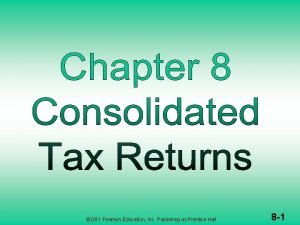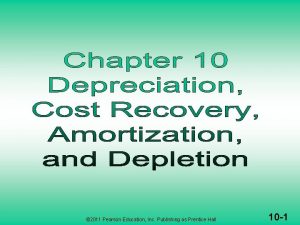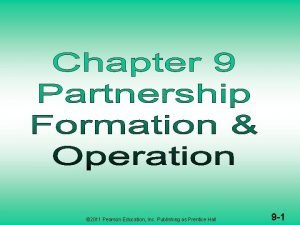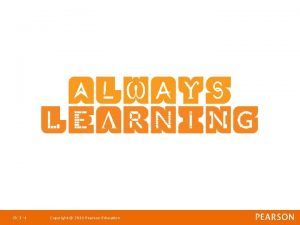Ch 6 1 Copyright 2011 Pearson Education Strategic





































- Slides: 37

Ch 6 -1 Copyright © 2011 Pearson Education

Strategic Management: Concepts and Cases Arab World Edition Fred R. David Abbas J. Ali Abdulrahman Y. Al-Aali Chapter 6: Strategies in Action Ch 6 -2 Copyright © 2011 Pearson Education

Long terms objectives • • long-term objectives represent the results expected from pursuing certain strategies represent the actions to be taken to accomplish long term objectives.

Long-Term Objectives Characteristics : • Quantifiable • Hierarchical • Measurable • Obtainable • Realistic • Congruent • Understandable • Timeline • Challenging Ch 5 -6 Ch 6 -6 Copyright © 2011 Pearson Education

Long term objectives Benefits: • • Help stakeholders understand their role in an organization's future. Provide basis for consistent decision making by managers whose values and attitudes differ. They serve as standards by which employees and the entire organization can be evaluated. Provide the basis for designing jobs. Provide direction and allow for organizational synergy. Minimize conflicts. Provide aid in the allocation of resources.

Financial vs. Strategic Objectives Financial Objectives • Growth in revenues • Growth in earnings • Higher dividends • Higher profit margins • Greater return on investment • Higher earnings per share • Rising stock price • Improved cash flow Ch 5 -8 Ch 6 -8 Copyright © 2011 Pearson Education

Strategic Objectives • • Larger market share Quicker on time delivery higher product quality Achieving ISO-14001 certification.

• • • Without long-term objectives an organization would drift toward some unknown end. Success occurs by accident only rarely. Success is the result of hard work directed toward achieving certain objectives.

Not Managing by Objectives • Managing by Extrapolation – If it not broke, don’t fix it. The idea is to keep on doing about the same things in the same ways because things are going well • Managing by Crisis – The true measure of a good strategist is the ability to fix problems. so its a reaction rather than actions letting events dictate management decisions. • Managing by Hope – The future is full of uncertainty and if first you don’t succeed, then you may on the second or third try. Ch 5 -9 Ch 6 -9 Copyright © 2011 Pearson Education

Depending on their capabilities and potential companies may display 3 postures : 1 -Growth (offensive) 2 -Retrenchment ( ( (ﺗﺨﻔﻴﺾ ﻧﻔﻘﺎﺕ Defensive) 3 -Stability *Offensive : since its growth position then it involves increasing investment *Defensive: a position where a company seeks to protect its position and take actions that limits the size of its market involvement. *Stability : avoid change <=== this position is not common in international scale , only in small enterprises. Ch 5 -12 Ch 6 -12 Copyright © 2011 Pearson Education

Types of Strategies Forward Integration Strategies Backward Integration Horizontal Integration Ch 5 -13 Ch 6 -13 Copyright © 2011 Pearson Education

Integration Strategy : Vertical and Horizontal • • • These strategies allow a firm to gain control over distributers, suppliers , and competitors. Vertical integration can be forward or backward. Forward Integration: gaining ownership or increased control over distributers or retailers. This strategy is implemented when the company wants to achieve larger market share. Forward integration strategy became very popular with increasing internet appearance. Many manufacturing companies have built their online stores and started selling their products directly to consumers, bypassing retailers.

• • • Forward integration strategy is effective when: Few quality distributors are available in the industry. Distributors or retailers have high profit margins. Distributors are very expensive, unreliable or unable to meet firm’s distribution needs. The industry is expected to grow significantly. The company has enough resources and capabilities to manage the new business.

• • Backward Integration : seeking ownership or increased control of a firm’s suppliers. The primary aims of backward integration are to ensure the stability and the quality of materials and avoid fluctuations in prices. Backward integration strategy is most beneficial when: Firm’s current suppliers are unreliable, expensive or cannot supply the required inputs. There are only few small suppliers but many competitors in the industry. The industry is expanding rapidly. Suppliers earn high profit margins. A company has necessary resources and capabilities to manage the new business.

• • Horizontal Integration : seeking ownership of or increased control over a firm’s competitors. thru mergers , acquisitions and takeovers. It is most effective when: When an org can gain monopolistic characteristic legally. when an org competes in a growing industry. when a company has necessary resources and capabilities (human talent and capital) to manage the new expanded org. when competitors are faltering ( ﻣﺘﻌﺜﺮﺓ but not doing poorly).

Examples Forward Integration Aramco has domestic and international refineries Backward Integration a clothing manufacturer may purchase one of its suppliers of fabrics to lessen the cost of raw materials Horizontal Integration Almarai acquired Teeba dairy company in Jordan, Beyti in Egypt, HADCO, and Al Safwa Dairies Ch 5 -17 Ch 6 -17 Copyright © 2011 Pearson Education

Types of Strategies Market Penetration Intensive Strategies Market Development Product Development Innovation Referred to as intensive because they require intensive efforts to improve its product Ch 5 -14 Ch 6 -14 Copyright © 2011 Pearson Education

Market Penetration • • Strategy seeks to increase market share for present products/services in present market through greater marketing efforts. HOW? ? When is this strategy effective : current market is not saturated with a particular product/service. Usage rate of present customers can be increased. When market share of major competitors have been declining when correlation between dollar sales and dollar marketing expenses is high

Market Development • • • Involves introducing present products/services into new geographic areas. the strategy will be effective when : when new channels of distribution are available that are reliable inexpensive and good quality. when new untapped markets exist. when a company has the needed resources and capital to manage the new expanded operations. when org has excess production capacity

Product development • • a strategy seeks increases sales by improving or modifying present products/services (extending the life cycle of a product) Or creating a new product that is related to the existing product for example : full fat , low fat and skimmed milk Strategy can be effective when : when an org has successful product so it can attract satisfied customers to try improved product. when competitors offer better quality products. when a company has strong research and development capabilities. when org. compete in a high-growth industry.

Innovation • • creating completely new product. Requires investing large capital in R&D. its most effective strategy to pursue when: the industry is in rapid change. competitors come up with new product economy is experiencing high growth when a company has strong research and development capabilities. when org facing tough competition and under pressure to shorten the life cycle of its existing product.

Types of Strategies Related Diversification Strategies Unrelated Diversification Ch 5 -15 Ch 6 -15 Copyright © 2011 Pearson Education

Related Diversification • • • Businesses are said to be related when their value chain (operations) possess cross-business strategic fit or synergy Transferring valuable expertise , tech know-how from one business to other. Exploiting common use of a well-known brand name



Unrelated Diversification • • this strategy favors capitalizing upon a portfolio of businesses that has excellent financial performance. search for new businesses across different industries. “Don't put all your eggs in one basket” Examples in saudi arabia ? ?


Types of Strategies Retrenchment Defensive Strategies Divestiture Liquidation Ch 5 -16 Ch 6 -16 Copyright © 2011 Pearson Education

Retrenchment: • • • Sometimes called a turnaround or reorganizational When organization reduce cost and assets to reverse declining sales and profits. ex. selling of land buildings to raise needed cash , closing factories , automating process =>reduce employees=>reduce cost.

Divestiture • • Selling a division or part of organization. often used to raise capital for further investment to get rid of unprofitable businesses that require too much capital or to focus on their core business and become less diversified.

Liquidation • • • Selling of a company’s assets in parts. Its an emotionally difficult strategy however it may be better than to continue losing large sums of money. usually this strategy comes when the org has pursued both retrenchment and divestiture and they were not successful.

Examples Retrenchment Divestiture Liquidation Nakheel, the property unit of Dubai World, cut several jobs in 2008 and 2010 Zain sold its operations in Africa to Bharti Airtel, India Iraqi government decided to liquidate the assets of Iraqi Airways Ch 5 -20 Ch 6 -20 Copyright © 2011 Pearson Education

Means for Achieving Strategies • Joint Venture/Partnering • Mergers and Acquisitions • Outsourcing Ch 6 -24 Copyright © 2011 Pearson Education

Joint Venture/Partnering • • Ch 6 -25 Joint venture is a popular strategy Two or more companies form a temporary partnership for the purpose of capitalizing on some opportunity. Copyright © 2011 Pearson Education

Mergers and Acquisitions • These are two commonly used ways to pursue strategies • A merger occurs when two organizations of about equal size unite to form one enterprise A acquisition occurs when a large organization purchases a smaller firm or vice versa • Ch 6 -26 Copyright © 2011 Pearson Education

Mergers and Acquisitions (cont’d) Key reasons why mergers and acquisitions fail: • Inability to achieve synergy • Too much diversification • Mergers overly focused on acquisitions • Too large an acquisition • Difficult to integrate different organizational cultures • Reduced employee morale due to layoffs and relocations Ch 6 -27 Copyright © 2011 Pearson Education

Outsourcing Business-Process Outsourcing (BPO) Companies taking over the functional operations of other firms such as HR , IT. Reasons to outsource : 1 -cost reduction. 2 -to focus on its core business 3 -better service Ch 6 -31 Copyright © 2011 Pearson Education
 Pearson education 2011
Pearson education 2011 2011 pearson education inc
2011 pearson education inc 2011 pearson education inc
2011 pearson education inc 2011 pearson education inc
2011 pearson education inc 2011 pearson education inc
2011 pearson education inc 2011 pearson education inc
2011 pearson education inc 2011 pearson education inc
2011 pearson education inc Pearson education inc. publishing as prentice hall
Pearson education inc. publishing as prentice hall 2011 pearson education inc
2011 pearson education inc 2011 pearson education inc
2011 pearson education inc Pearson education 2011
Pearson education 2011 2011 pearson education inc
2011 pearson education inc 2011 pearson education inc
2011 pearson education inc 2011 pearson education
2011 pearson education 2011 pearson education inc biology
2011 pearson education inc biology 2011 pearson education inc
2011 pearson education inc 2011 pearson education inc biology
2011 pearson education inc biology 2011 pearson education inc
2011 pearson education inc 2011 pearson education inc
2011 pearson education inc 2011 pearson education inc
2011 pearson education inc 2017 pearson education inc
2017 pearson education inc 2017 pearson education inc
2017 pearson education inc Copyright 2010 pearson education inc
Copyright 2010 pearson education inc 2009 pearson education inc
2009 pearson education inc Copyright pearson education inc
Copyright pearson education inc 2014 pearson education inc
2014 pearson education inc Copyright 2010 pearson education inc
Copyright 2010 pearson education inc Copyright 2010 pearson education inc
Copyright 2010 pearson education inc Copyright by pearson education inc. answers
Copyright by pearson education inc. answers 2008 pearson education inc
2008 pearson education inc Copyright 2009 pearson education inc
Copyright 2009 pearson education inc 2015 pearson education inc
2015 pearson education inc Copyright 2010 pearson education inc
Copyright 2010 pearson education inc Copyright 2010 pearson education inc
Copyright 2010 pearson education inc Copyright 2010 pearson education inc
Copyright 2010 pearson education inc Copyright 2010 pearson education inc
Copyright 2010 pearson education inc Copyright 2010 pearson education inc
Copyright 2010 pearson education inc Copyright 2010 pearson education inc
Copyright 2010 pearson education inc




























































